QuestionQUESTION: I got Lucky in in February 2007 as a birthday gift. He has always been very active, building bubble nests, dancing for me and keeping me company in my office at work. I keep his water clean and the temp constant (high 70s to low 80s). Never had a problem with his eating habits or any of the other ailments I've read about.
About four months ago, however, he began to develop a large bump, or what appeared to be a tumor or wart. As the mass grew, it would eventually fall off, but then another one would take its place and repeat the cycle. Over the past
two months however, Lucky has completely changed his activity and constantly lies on the bottom of his tank and only goes to the top to breath or eat, and then basically sinks back to the bottom. Each weekend when I come back to my office, praying he's still with me, there he is!
I assume he's just getting old and on his way out, but if this is the case, I certainly don't want him to be suffering. Do you have any thoughts or suggestions? Nobody seems to write about these tumors/warts, so I'm at a loss. One person told me when they sink to the bottom or lie on the bottom, they are simply old and ready to die.
Please help me help my little guy!!!
Thank you,
Traci
ANSWER: Hi Traci,
Poor Lucky, I'll try my best to help.
Identifying lumps and bumps is very difficult with fish unless you have a laboratory for testing and determining what the bump is caused by.
I have found a short article describing some lumps and bumps on fish and I feel it might be of some help-
------------------------------------
"Lumps and bumps: there are a number of diseases that begin this way. (1) tumors or lymphocystis which are viral in origin and not treatable, (2) fish pox which is also viral and not treatable (3) various forms of ulcer disease which are caused by Pseudomonas or Aeromonas and are treatable, (4) HITH or LLE which has varied causes and treatments, (5) Costia - a parasite that nearly always causes little red hemorrhages, especially under the chin, (6) various bacterial diseases caused by such as Columnaris, (7) Neoplasm formations.
Lumps and bumps that suddenly appear are usually bacterial infections. If the disease process is due to bacteria, it usually resolves by rupture (like a boil) pretty quickly. The white liquid that oozes out is pus that is formed when the white blood cells (immune cells) die while killing bacteria (in general). NEVER TRY TO POP OR SQUEEZE THE LUMP. Like a boil in humans, squeezing can cause regurgitation of the pus into the blood stream of the fish with deadly results. It is also not a good idea to seal a draining wound unless it is bleeding. The most common bacteria which causes such lumps is Columnaris or Aeromonas.
Wounds that are white on the edges and red in the center are most typically Aeromonas. Those that are red on the edges and white in the center are generally Columnaris. Both are gram negative bacteria. The best treatment for this is any sulfa antibiotic with trimetheprim. This can be put in the water and mixed with food -- if you can find Romet B use it.
Some research indicates that certain carbon filter materials may predispose fish to this disease though the mechanism has not been determined. Better nutrition (provide calcium/phosphorus/vitamin D supplement), less crowding, more water changes may help. Change brands (marineland is good) or don't use filter carbon at all.
Treatment for any other 'bumps' and 'lumps' may be treated by a bath of potassium permanganate. You can often obtain this at your local pharmacy.
Notes on the use of potassium permanganate. 1 drop of stock PP per gallon is equal to 2 ppm. This is the concentration used for continuous treatment. PP is usually used for 3 days, or every other day for 4 treatments. If water is not clear in 24 hours (looks yellow), change 25-30% of the water before adding another dose. Light inactivates PP. After adding the PP, watch for a minimum of 15 minutes to make sure there are no adverse reaction. Then turn off lights or cover the tank.
Some water seems to inactivate PP rapidly. It should be pink when you put it in, and stay pink for at least 4 hours to be effective.
Stock PP can be used on a swab on small wounds or patches of white "crud" on fins. It results in a chemical burn and turns the area dark. Do not use near the eyes, mouth or gills. Use as a one time application, followed by Neosporin creme or Panalog (by vet prescription).
Cautionary notes: Some water conditioners can inactivate some medication. NovAqua and PolyAqua will inactivating metals and quickly inactivates potassium permanganate.
If you pursue combined RALLY/Kanamycin treatment, use it according to package label instructions, and add one dose of RALLY every 3 - 5 days. The active ingredients in RALLY are biodegradable; however, you should run carbon or a Polyfilter for a few hours (and then remove it) before adding a repeat dose.
Buy rally here ---> http://www.northcoastmarines.com/rally.html
Hydrogen peroxide is preferred for topical application near the mouth or gills. "
---------------------------------------------------
I hope he hangs in there. You may need a try a medication for bacterial infections and change his water like crazy (this is always a benefit)
My best wishes!
Karen~
---------- FOLLOW-UP ----------
QUESTION: Thanks for the article Kren, although none of the ones mentioned seem to be what Lucky is showing. I am very stumped. I have one more question though, which is really puzzling to me. The whole sinking thing. I've read a lot of information on the swim bladder, but when they have "swim bladder disease", they are normally floating rather than sinking. If the swim bladder isn't working correctly though, I would think it could also have the opposite effect. Any thoughts on this?
AnswerHi there,
Yes Swim bladder can definitely have the both effects on bettas. There is a type called "floaters" where the fish floats miserably and uncontrollably at the top. Then there is the "Belly sliders" type where they sink to the bottom and may only be able to get up a few inches from the gravel before they sink back down.
Fish with swim bladder usually heal on and recover on their own. But since food is almost always the culprit (feeding too much at one time or not enough variety) cutting back and letting the fish fast for a few days often helps, as well as a green pea feeding (shell the peas first) which provides fiber to help things get moving and functioning. Some bettas are naturally more prone than others and some have re-occurring SBD.
I wish I could tell you what your betta has. You could try to send a picture if you like. This is the address if you are interested-
nature_girl2u@hotmail.com
A picture may help in trying to identify the bump. Which I am suspecting is bacterial. You may try consulting other experts here or on trusted forums like http://forums.tfhmagazine.com/ and post on their sick fish forum.
What I'd do now is change the water everyday (if he is in a container, do 100% everyday with conditioned water of equal temp to his container) If in a tank of 2 gallons or more. Change up to 60% of his water making sure the bottom is clean. And I might use Jungle Brand's "Fungus Clear" which also treats bacterial infections. It have used it repeatedly and it does not stress fish out. The dosage for 1 gallon tanks is-
*Dissolve 1 tablet in 10 tablespoons of water
*Add 1 tablespoon per gallon
For now, I'd repeat this daily dosing and water changes until we can come up with something better.
I wish you and Lucky the best!
Karen~

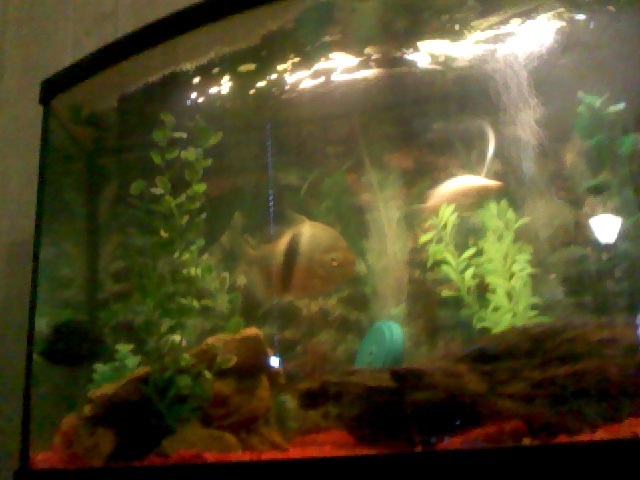 46 gallon tank
Questionmy tank
QUESTION: hello in my tank I use
46 gallon tank
Questionmy tank
QUESTION: hello in my tank I use
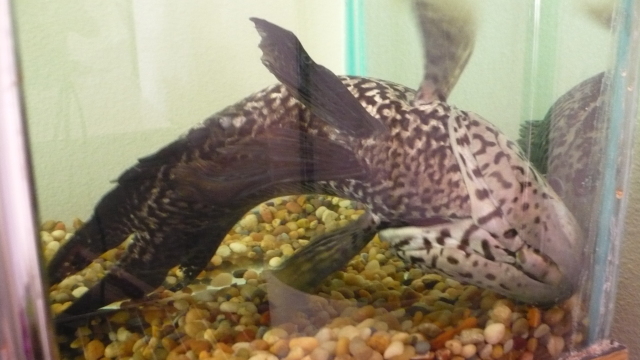 Swim Bladder Problem
Question
Buttnippers Problem
I have an 8 yr old Manguan
Swim Bladder Problem
Question
Buttnippers Problem
I have an 8 yr old Manguan
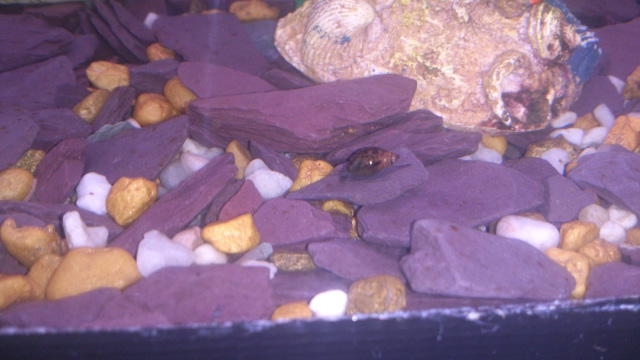 snails
Question
snail
Hi
I have recently set up my aqua
snails
Question
snail
Hi
I have recently set up my aqua
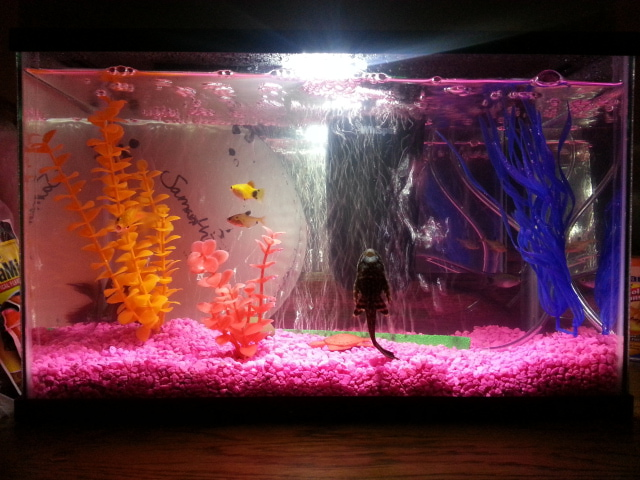 help! I have a new 5 gal tank & too many fish, I think
Question
aquarium
My daughter won 2 goldfish at
help! I have a new 5 gal tank & too many fish, I think
Question
aquarium
My daughter won 2 goldfish at
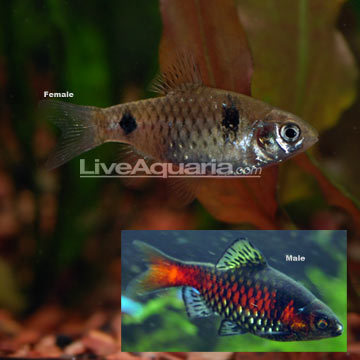 odessas
QuestionQUESTION: hi i ve got 2 odessa barbs one of min
odessas
QuestionQUESTION: hi i ve got 2 odessa barbs one of min